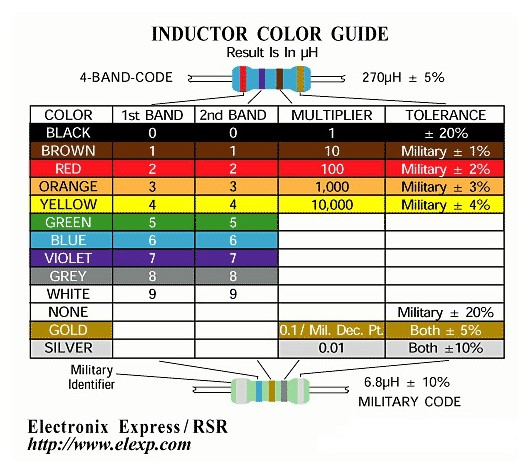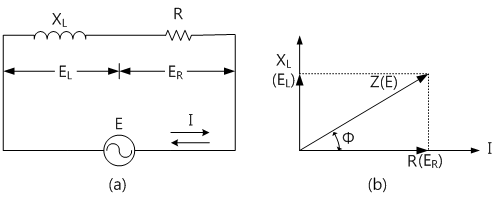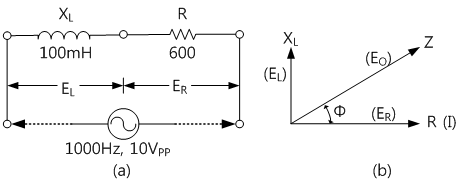PART1R, L, C Circuit
Experiment 14 :AC RL Circuit
Theory
The characteristic of AC resistance XL of inductor is that the phase of current and voltage has the difference of 90°. However, if R, DC resistance is included to the coil in series, its combined resistance(impedance) Z can be expressed as the formula below and the relationship between voltage and current follows Ohm’s law.

Fig.1-23 shows R-L serial circuit and the combined resistance(impedance) becomes Z = √R2+XL2. And if DC resistnace R exists at the circuit, the phase difference of voltage to current becomes as fig.(b), not 90°. If there is no AC resistance(reactance), the calculation of load power can be done as P=IE. However, in AC circuit, because of the phase angle of current-voltage, the case is different from the load having DC resistance only. The ratio of impedance Z and R is called power factor and is expressed as PF=R/Z=cosФ. Here, the power of R load is called defective power and that of Z is called apparent power, which can be expressed as below.

Experiment Process
1. Connect the AC power as fig.1-24(a), change the frequency according to table 1-14, and measure EL, ER and record the result in the relevant column. Calculate the impedance Z with the given formula and record the result.
tab1Experiment 1-14.1 AC RL Circuit (Compose as in fig.1-24(a).)
1.Connection
1.Circuit Connection
Function Generator connection
Connect between A+ terminal of Signal Output on front panel and left terminal of R9 of Block f with red line, and between A- terminal and lower terminal of L1 with black line.
Voltmeter Connection
Connect between A+ terminal of Signal Input CH A on front panel and left terminal of R9 of Block f with red line, and between A- terminal and right terminal of R9 with black line.
Connect between B+ terminal of Signal Input CH B on front panel and upper terminal of L1 of Block f with red line, and between B- terminal and lower terminal of L1 with black line.
2.Wiring Diagram
3.Measurement
- 1Choose analog output at left menu of front panel.
In Function Generator window, set up Amplitude as ,amplitude 50% , Frequency as , Signal as and click to output 1KHz 10Vp-p.
- 2Choose analog input at left menu of front panel.
Choose Volt & Ampere Meter tab and choose , , at CH A and CH B, then the measured value is indicated. Record it in the relevant column of table 1-13. CH A is EL value, and CH B is ER value.
- 3Choose analog output at left menu of front panel.
In Function Generator window, choose Frequency as , click to make 500Hz frequency 500hz and execute 2) process.
In Function Generator window, choose Frequency as , click to make 1500Hz frequency 1.5khz and execute 2) process.
In Function Generator window, choose Frequency as , click to make 2000Hz frequency 2khz and execute 2) process.
- 4After the measurement, click to cut off the output of function generator.
4.Calculation
1. In table 1-14, calculate the impedance Z with given formula and record the result.
Experiment Result Report
1. Experiment Result Table
<Table 1-14>(R9=1.2kΩ, L1=53uH)
| Frequency | EL | ER | Z = √R2+XL2 |
|---|---|---|---|
| 500 ㎐ | |||
| 1000 ㎐ | |||
| 1500 ㎐ | |||
| 2000 ㎐ |
2. Review and Explanation
1) Calculate XC per each frequency, calculate the impedance by Z formula and calculate the voltage between capacitor’s both ends and the voltage between the resistance’s both ends using Ohm’s law
2) Calculate XL per each frequency, calculate the impedance by Z formula and calculate the voltage between coil’s both ends and the voltage between the resistance’s both ends using Ohm’s law
3) Compare the calculated value with the measured value.
3. Discuss the experiment result.










